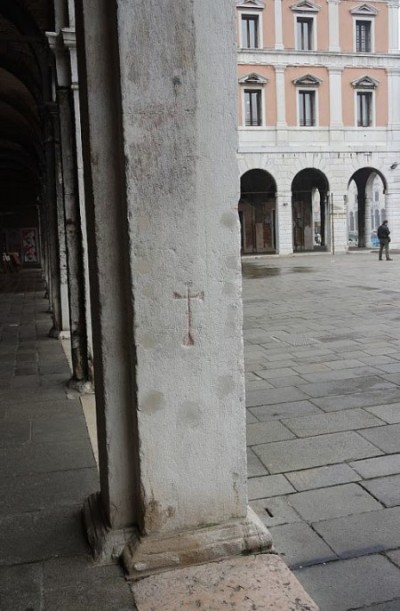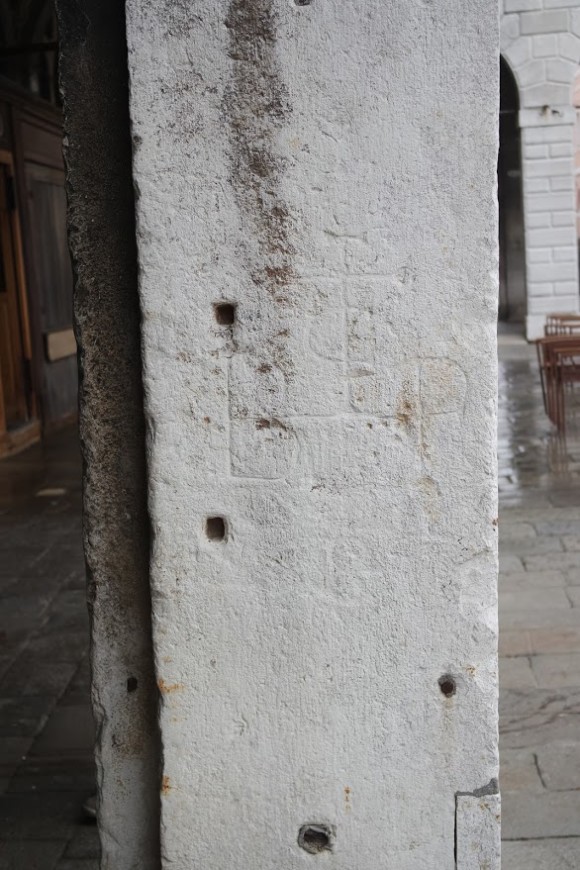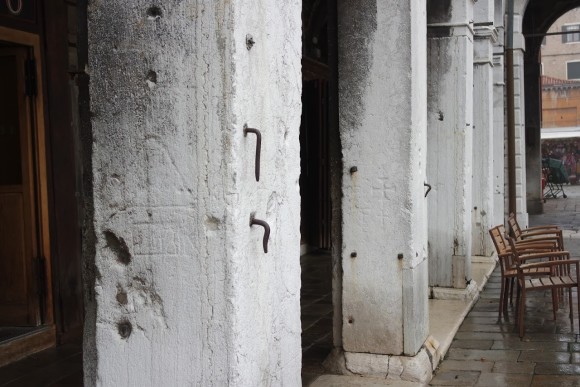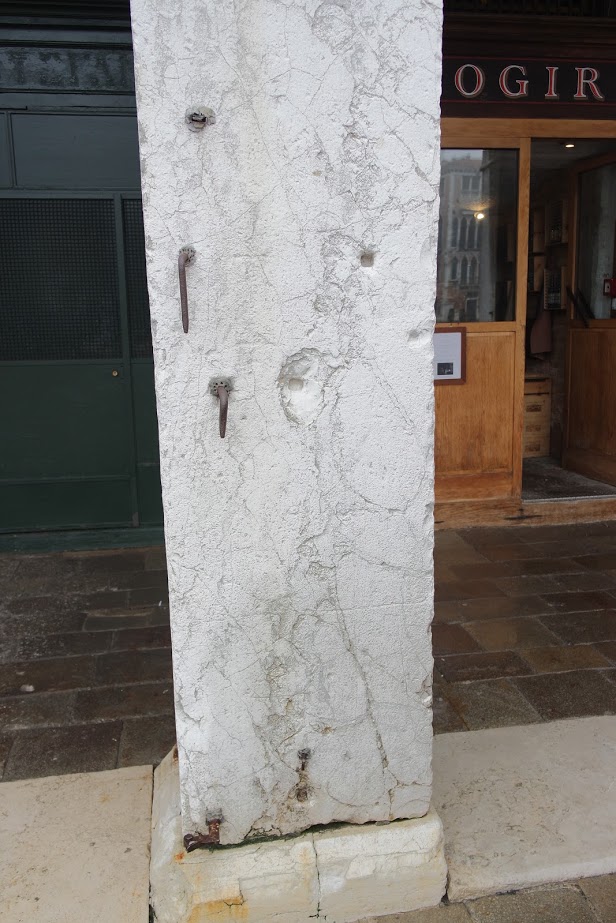Search results
7 results found.
7 results found.


Talk about Venetian history long enough — say, eight minutes, or even fewer — and you will almost certainly refer at least once to Napoleon Bonaparte. If you are somehow able to avoid mentioning him, you should embed the secret in a cellphone game because I think it would be a challenge.
And why is this? Because on May 12, 1797, his army entered Venice and the Venetian Republic fell forever. That was one day. Then the damage really began.
Napoleon craved Venice for several reasons, one of which was that it was the richest city in Europe. He needed money to pay for his wars, and when he was done, the city was eviscerated of tons of art works, precious metals, and gems. His soldiers spent two weeks carting treasures out of the basilica of San Marco. What he stripped from the “Bucintoro,” the doge’s state barge, was enough to keep most of us in Kobe steak for the rest of our lives.
Even if you didn’t know that, you walk through his handiwork in the course of any ordinary stroll here — through campos named for saints whose churches are nowhere to be found, for example — because the Venice we see today is the result of months of devastation wrought upon the city in the fulfillment of his ideas.

If you want to try to imagine the city before it was disemboweled (I often try, and usually fail), here is a partial list of the buildings Napoleon got his hands on. My source is “Storie delle Chiese dei Monasteri delle Scuole di Venezia Rapinate e Distrutte da Napoleone Bonaparte” by Cesare Zangirolami (Filippi Editore – Venezia). Some of these structures were completely demolished, some merely gutted and abandoned, or decommissioned, so to speak, like sinking battleships, and used as warehouses (coal, tobacco, etc.) or assorted other really practical purposes, such as barracks. A few have been restored and resuscitated, but not to their former use — you’ll recognize the names of some you’ll have at least walked past. This list does not include the 80-some palaces he razed. Nor the tombs of doges and patricians which have disappeared. But the book does list each work of art which is gone forever.
Abbey of San Cipriano
Churches:
Dell’Anconeta. Sant’Agnese, Sant’Agostino, Sant’Anna, Sant’Antonio Abate, Sant’Anzolo, Sant’Apollonia, Sant’Aponal, dell’Ascensione, San Basegio, San Basso, San Bernardo, San Biagio, San Biagio e Cataldo, San Boldo, San Bonaventura, Cavalieri di Malta, della Celestia, delle Convertite, del Corpus Domini, della Croce, della Croce alla Zuecca, San Cataldo, Santa Chiara, Santa Chiara di Murano, Santi Cosma e Damiano, San Daniele, San Domenico, Sant’Elena, Santi Filippo e Giacomo, San Geminiano, San Giacomo di Rialto, San Giacomo della Zuecca, San Giovanni Battista, San Giovanni Battista dei Battuti, San Giovanni dei Furlani, San Giovanni Laterano, San Girolamo, San Giuseppe di Murano, Santa Giustina, della Grazia, San Gregorio, Santa Lena, San Leonardo, San Lorenzo, Santi Marco e Andrea, Santa Margarita (sic), Santa Maria Annunziata, Santa Maria Celeste, Santa Maria degli Angeli, Santa Maria della Carita’, Santa Maria delle Grazie, Santa Maria delle Vergini, Santa Maria del Pianto, Santa Maria Maddalena, Santa Maria Maggiore, Santa Maria Nova, Santa Marina, Santa Marta, San Martino Vescovo, San Matteo Apostolo, San Matteo di Murano, San Mattia, San Maurizio, San Michele Arcangelo, San Nicoletto della Lattuga, San Nicolo’ di Bari, Ognissanti, San Paternian, San Pietro Martire, San Provolo, del Santo Sepolcro, dello Spirito Santo, San Salvador di Murano, Santa Scolastica, San Sebastiano, San Severo, Santa Sofia, San Stefano di Murano, San Stin, Santa Ternita, della Trasfigurazione, della Santissima Trinita’, dell’Umilta’, San Vio.
Islands (not the islands themselves but the edifices upon them) :
Sant’Andrea, la Certosa, San Cristoforo della Pace, San Giorgio in Alga, della Grazia, San Secondo.
Monasteries: (in some cases the structures remain and are even in use, but he dismembered their congregations, some of which were admittedly small, but still. I’ve been to many offices which are housed in former convents and cloisters).
Sant’Anna, Sant’Antonio Abate, San Bernardo, Santi Biagio e Cataldo, Santa Chiara di Murano, Santi Cosma e Damiano, della Croce, San Daniele, delle Dimesse, San Domenico, San Francesco della Vigna, San Giacomo, San Giovanni Battista, San Giovanni Laterano, San Giuseppe, San Lorenzo, Santi Marco e Andrea, Santa Maria degli Angeli, Santa Maria dei Servi, Santa Maria delle Vergini, Santa Maria del Pianto, Santa Maria Maddalena, San Martino Vescovo, San Matteo, San Mattia, San Michele di Murano, San Pietro Martire, del Santo Sepolcro.
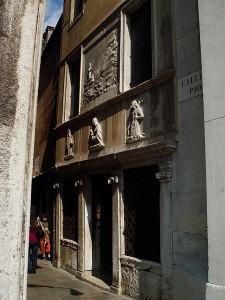
Oratorio della Concezione, Oratorio di Sant’Orsola.
Ospitale degli Incurabili, Ospitale dei Marinai.
Patriarcato (at San Pietro di Castello, the palace of the Patriarch of Venice till 1807, when San Marco was made the city’s cathedral).
Priorato (Priory) di Malta
Scuole (headquarters of the many guilds and confraternities):
degli Albanesi, della Carita’, San Francesco, San Girolamo, San Giovanni dei Battuti, San Giovanni Evangelista, della Madonna della Pace, San Marco, Santa Maria e Cristoforo, dei Mercanti, della Misericordia, del Nome di Gesu’, dei Pittori, della Santissima Trinita’, dei Stampatori e Librai, San Stefano, San Teodoro, dei Varoteri.
And people talk about Attila.
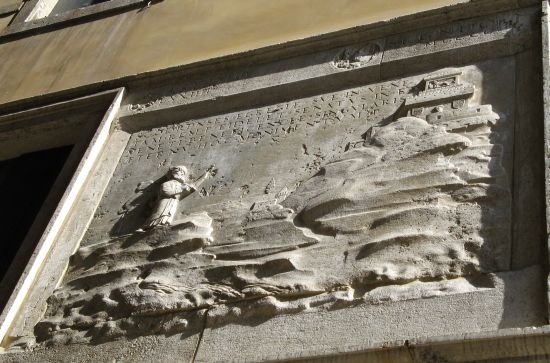
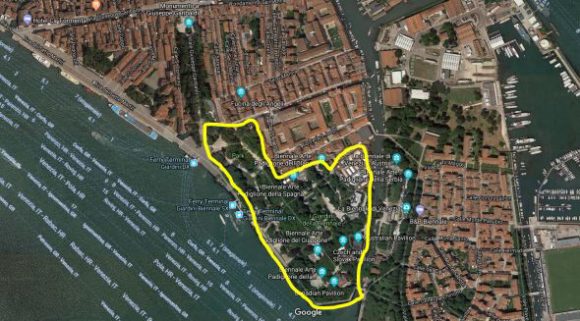
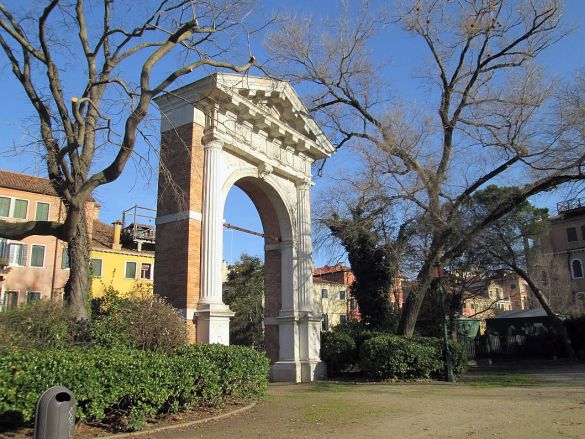
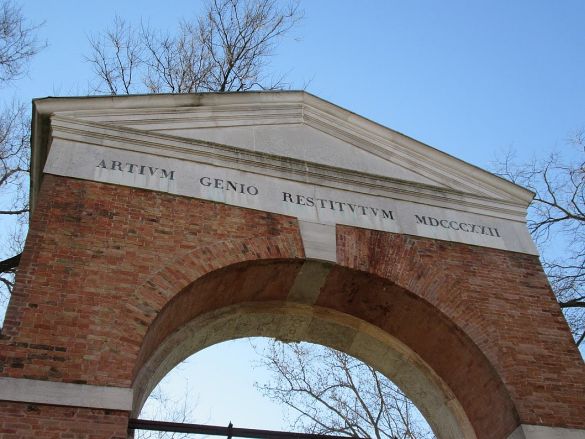
This sylvan glade was created by Napoleon when he went through Venice like the Destroying Angel, razing and demolishing scores of churches, convents, scuole and other buildings that were inconsiderately sited where he wanted something else to be, or that happened to contain things he wanted such as gold, jewels and works of art.
Nowadays the Giardini Pubblici (Public Gardens) are best-known for accommodating the original pavilions of the art extravaganza known as the Biennale. Also, being a garden, the area is full of trees and flowers and shrubs, plus an attractive little playground. It even offers a useful amount of space to handle thousands of runners at the finish line of the Venice Marathon.
However, this 13-acre piece of Venice is more than a shrine for art lovers or a bosky dell for the relief of exhausted tourists. It is a garden of remembrance(s) of people and/or events of which hardly anybody remembers anything. That’s a wild guess on my part, based on the general nonchalance with which people wander through. Look at the bronze bust of Giorgio Emo Capodilista; it has “And now the weather report from Oblivion” written all over it. Not to mention Carlo de Ghega, another extremely worthy Venetian whose crumbling memorial plaque is only about 45 seconds away.
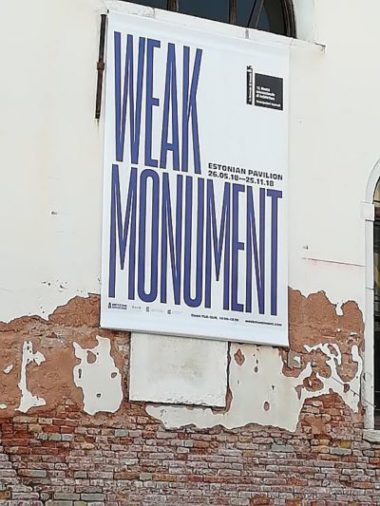
So I’ve decided — SEEING THAT THERE ARE NO HELPFUL EXPLANATORY SIGNS ANYWHERE, THE KIND THAT MANY TOWNS WHOSE CITIZENS AND OFFICIALS FEEL SOME CIVIC PRIDE OFTEN PLACE NEAR WORTHY LANDMARKS — to remedy this oversight. I’m limiting myself to the Gardens at the moment, because I intuit that trying to address the skillions of other personages “remembered” around Venice would be a life’s work. Not a reason not to do it, just a reason to evaluate it carefully.
But the Gardens are calling. May I present Riccardo Selvatico, our first example of departed glory:
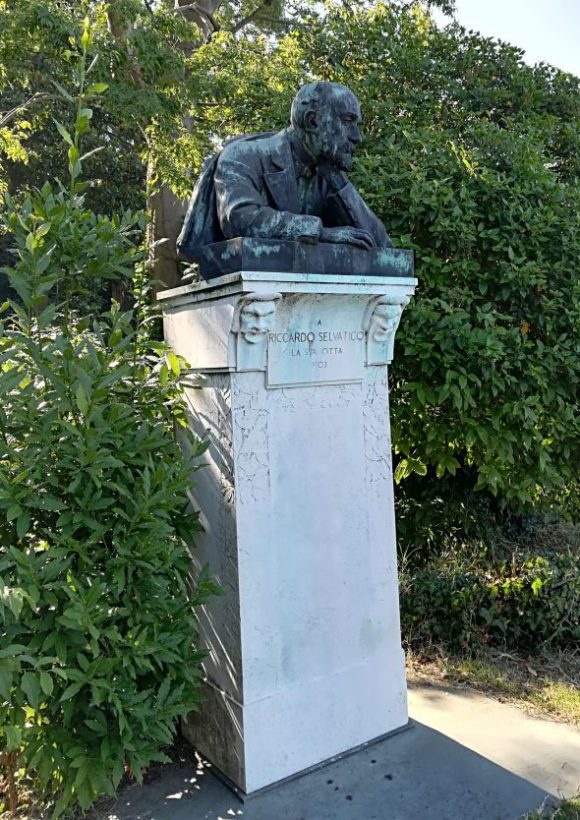
Selvatico was born in Venice in 1849 and died in 1901. Trained as a lawyer, he was mayor of Venice from 1890-95. He was also a poet and writer of comedies (I guess politics could help you with that) written in the Venetian dialect. When he wasn’t scribbling he did a number of important things. For one, he established a fund to finance the construction of healthier housing, replacing swathes of dwellings which were worthy of New York’s Lower East Side or Rio’s favelas; he would have lived through several cholera epidemics, so he didn’t need anybody to explain the problems of slums.
And if that doesn’t seem especially herm-worthy, he was also the person who came up with the idea, approved by a city-council vote in 1894, of holding an international art exposition in Venice every two years. In other words, he invented the Biennale, which now runs for at least six months, and sometimes seven, every year. It brings glory to the participants and boatloads of money to the city — I have no way of knowing which aspect inspired him more. Maybe it was a draw. The opposition party, naturally, stigmatized it as yet another example of his administration’s tendency to waste money on projects of barely discernible utility, in order to favor its friends and clients.
So he wrote a little poem called “Metempsicosi” in which he imagines that if it were true that we can be reincarnated as some animal, he’d like to come back as a pigeon in the Piazza San Marco, watch the people, fly around, and poop on the hats of a couple of individuals he isn’t going to name.
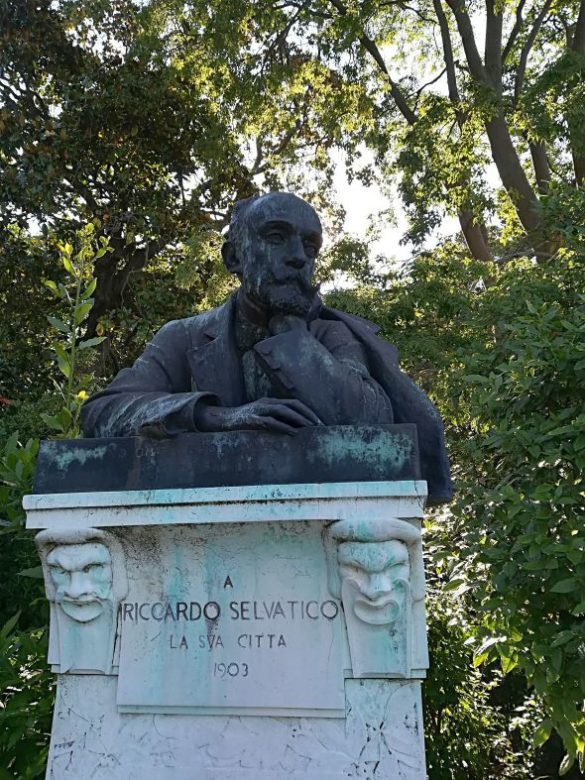
His five years as mayor were busy, of course, partly due to an ongoing battle between his highly eclectic and non-religious government and the opposition party marshaled by Giuseppe Sarto, then patriarch of Venice but later Pope Pius X. In 1895 Sarto’s faction won the election and Selvatico was back on the street. Separation of church and state was not an important principle at the time.
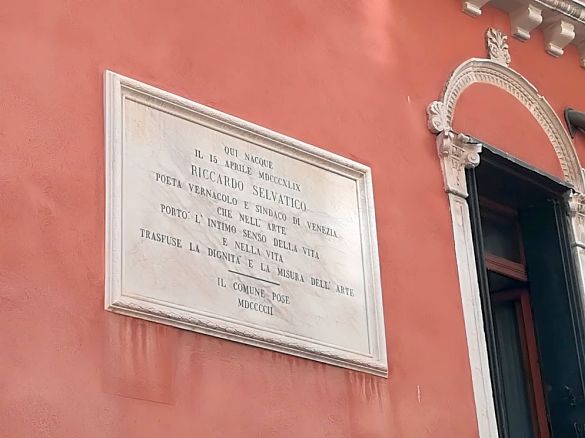

Selvatico clearly accomplished more than your usual assortment of Bepis and Tonis (“Bepi”and “Toni” are the immemorial nicknames of the quintessential pair of Venetian friends, up to and including today). I’m glad his efforts were appreciated, though the encomiums came after his death, as usual.
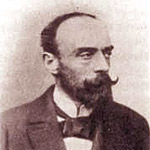
I Recini da Festa (“The best earrings”) is a comedy in two acts set in Venice, first performed in Venice to great success at the Teatro Goldoni on April 4, 1876 (14 years before he became mayor, so people knew what they were getting into, so to speak, when they elected him). One critic calls this comedy as “light and intricate as a piece of Burano lace,” still a stellar example of the best of the theatre in Venetian dialect of the time. Then as now, everybody spoke Venetian, so it wasn’t necessarily seen as a quaint way of talking, or even typical of a particular social class.
A poverty-stricken young married couple — also, she’s pregnant — is living with her parents because the husband has been rejected by his rich father who was opposed to the wedding. This opposition is based on an old quarrel between the two fathers-in-law dating from their youth, about which the newlyweds know nothing. Her father can’t support them all, so his wife breaks the piggybank in which the money for the crib was being kept.
But the baby MUST have a crib so that the father can at least put up a good appearance, therefore the daughter (soon to be mother) decides to pawn her best earrings. The person who resolves all the twists is the big-hearted and astute midwife, who’s ready to make any sacrifice to settle the matter. In the end the two old enemies make peace, and the rich father himself gives the earrings back to his daughter-in-law. Happy ending for everybody!
One critic calls this little confection “fresh, simple, full of domestic intimacy, which even today one hears willingly.”

Perhaps even better-known (among Venetians) is his poem “Brindisi” (toast), written in honor of the Regata Storica of 1893, and read by Selvatico at the then-traditional dinner given for all the racers the Thursday evening before the big event on Sunday.
That year the festivities were grand — nine new gondolinos had been constructed, and six bissone were bedecked at a cost of 3000 lire ($15,678 adjusted value). The rockstar pair of rowers, the Zanellato brothers, weren’t competing, and that left three crews which were virtually equal. Emotions were high even before the wine began to flow.
Like most poetry, it’s infinitely better spoken than read in silence, and I can only imagine the exultation that greeted the last few verses. I will translate, knowing that things like this come out in translation as if they’d been soaked in bleach. The original is below.
There are some who tremble/Looking around/And seeing that the world/Keeps going along every day
It seems that Venice/Once so beautiful/A little at a time/She too has changed
Mincioni/Let me say it/Venice doesn’t change/No matter how much people shout (terms in italics explained below)
The calle de l’Oca/has gone to hell/But the Grand Canal/For Lord’s sake, who would touch it?
They’ve gone to hell/parties and gambling houses/Dances, country festivals/
The Forze di Ercole/the puppet shows
So fine– but there is always/our Regata/There is always the festa/That nothing can affect (literally “impact”)
Cape, wig/ hat shaped like a raviolo/They’re dead and buried/But there is still the boatman!
And as long as this breed/Of arms and lungs/Of men who are tressi/sbragioni but good
As long as this breed/I repeat, is like this/Venice doesn’t change/Venice is beautiful!
————————————————————-
Mincioni: Refers to the male member; I’ve tried and can’t confidently give an English equivalent in the sense intended here, which summarizes all the great qualities of men’s men, in a good sense, even while using a word which usually implies the opposite.
Forze di Ercole: These “strengths of Hercules” were complicated human pyramids, spectacular exhibitions of endurance and equilibrium put on during festive occasions such as Carnival.
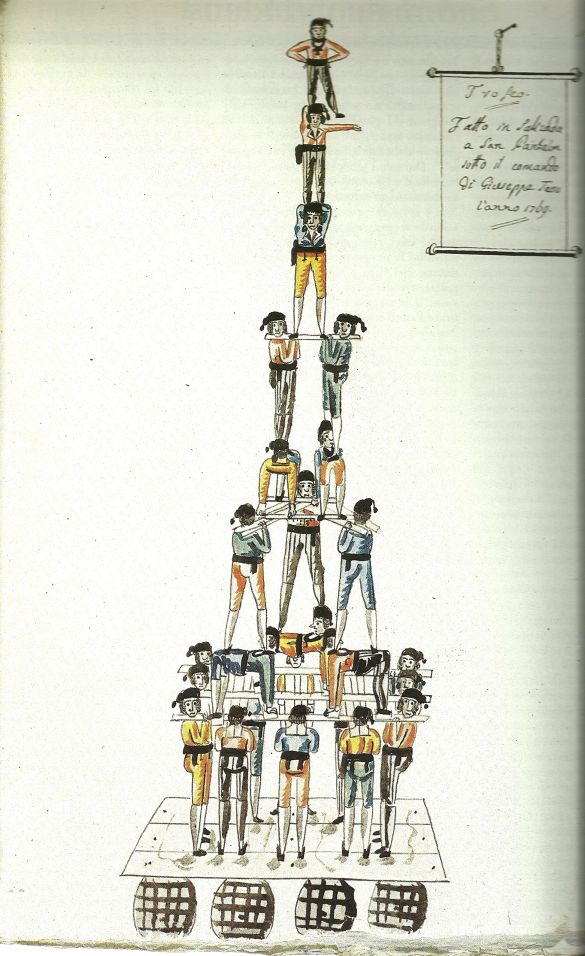
Hat like a raviolo: Tricorn
Tressi: A person who is a “tresso” (here he is using the plural to characterize boatmen in general) is big, strong, burly, muscular. I can imagine this inspiring an enormous burst of laughter, table- and friend-pounding, general uproar. What’s even better is that “tresso” is also the piece of wood which strengthens and unites two things that without it would collapse — for example, the legs of a chair (technically known in English as the “stretcher”). Calling somebody a tresso suddenly seems like a great thing.
Sbragioni: People called “sbragioni” are those who tend to yell when talking, especially with the belief that yelling will make the shouter win the argument. More laughter.

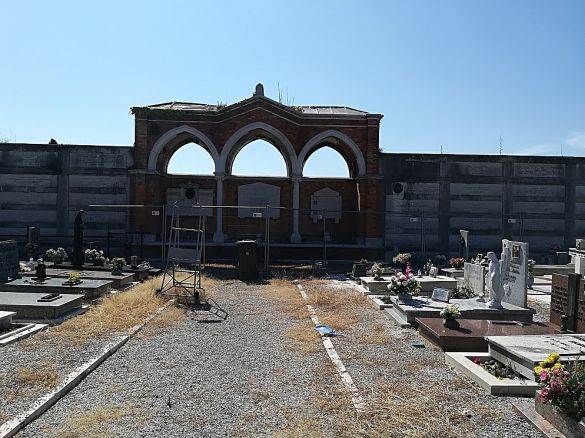
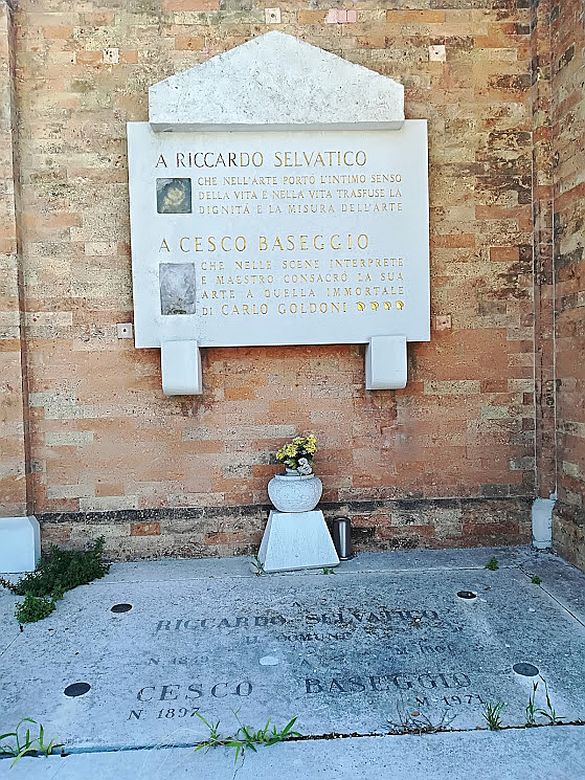

This is only the first personage to be rediscovered in the Garden of the Forgotten Venetians. Next chapter coming soon.
“Brindisi” for the Regata Storica by Riccardo Selvatico 1893
Gh’è certi che trema
Vardandose a torno,
E visto ch’el mondo
Camina ogni zorno,
Ghe par che Venezia
Un dì cussì bela,
Un poco a la volta
Se cambia anca ela.
Mincioni, mincioni,
Lassè che lo diga;
Venezia no cambia
Per quanto che i ziga.
Xe andada in malora
La cale de l’Oca;
Ma el so Canalazzo,
Perdio, chi lo toca?
Xe andai in so malora
Festini e ridoti,
I salti, le sagre,
Le forze, i casoti:
Va ben, ma gh’è sempre
La nostra Regata,
Gh’è sempre la festa
Che gnente ghe impata.
Velada, paruca,
Capelo a rafiol
Xe morti e sepolti;
Ma gh’è el barcariol!
E fin che sta razza
De brazzi e polmoni,
De omeni tressi,
Sbragioni ma boni,
In fin che sta razza,
Ripeto, xe quela,
Venezia no cambia,
Venezia xe bela!
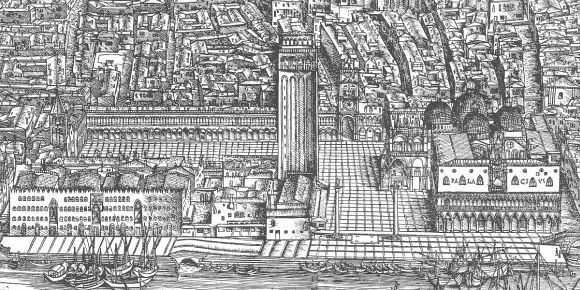
Aerial views of Venice reveal an unsuspected abundance of gardens and parks, which aren’t always apparent to the wanderer of the brick- and stone-walled streets. But one garden cum park is so obvious that I wonder how many people are even aware of it. Those who are, though, have long been disappointed, and like so many things that ought to be done but somehow aren’t, the Giardini Reali stretching between the Piazza San Marco and the lagoon have spent years in quiet, despairing decline.
Once or twice a year, an article would appear in the Gazzettino urging the campers and backpackers and picnickers who bivouac in the Piazza to avail themselves of the green space — with benches, even! — where they could munch and relax. But either the message didn’t get across, or many people looked through the rusty gate at the dusty, gravelly area which once was a garden and now had more of the atmosphere of an abandoned parking lot in Buffalo and had second thoughts. Dust in the summer you can sort of put up with, but a mid-day garden which affords NO SHADE is very hard to make appealing.
In any case, tell the truth: Did you have any idea there was a garden there?

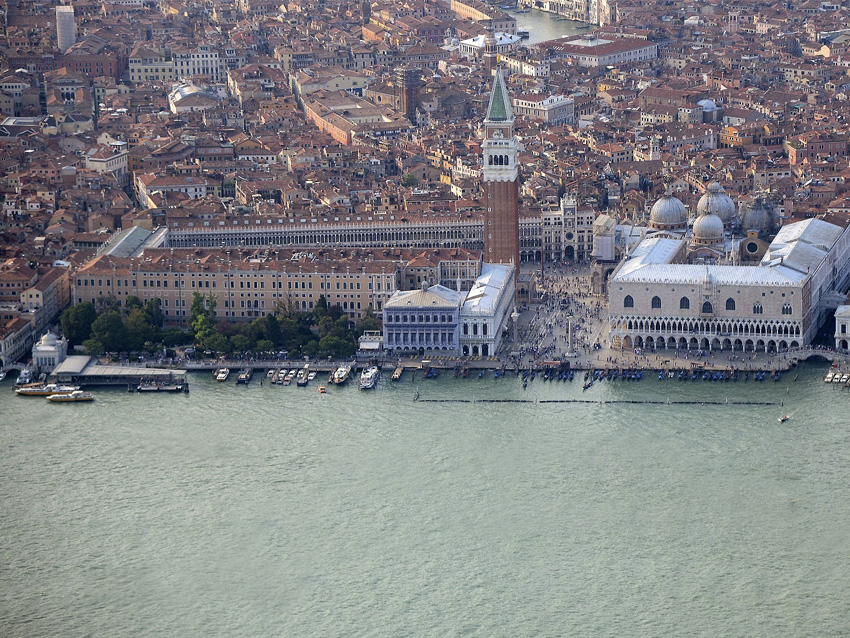
But I’m here with good news: The garden is coming back, with flowers and a fountain and SHADE. At least those are the glad tidings announced at a press conference last Friday by the Venice Gardens Foundation (which is new — you haven’t somehow missed it, but its website will compel you to brush up on your Italian), an ambitious undertaking launched with lavish funding from the Generali Insurance Company.
The “Royal Gardens” (your first hint that they do not date from the days of the non-royal doges) were created by the wish of Napoleon in 1806 according to a design by Giovanni Antonio Antolini. When he wasn’t razing and demolishing swathes of Venice, Napoleon was transforming them. No sooner had he turned the Procuratie Nuove into the Royal Palace than he commissioned an adjoining garden, because as we all know, a palace must have a garden. Just look at Versailles. Napoleon may have been all about egalite’, but only up to a point.
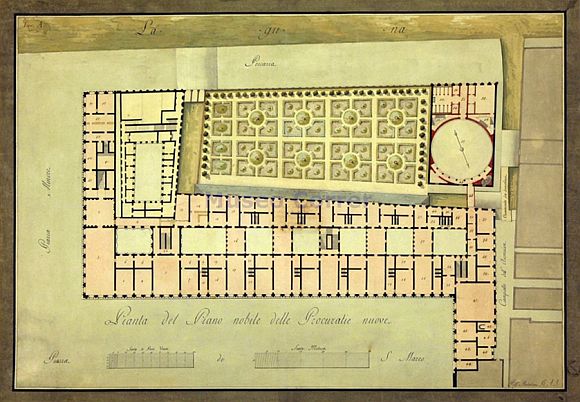
So a garden was decreed and so it was, and so it continued under the Austrian occupiers and on into the epoch of the Republic of Italy, when I suppose the nervous sensation that no ghe xe schei to maintain it began to be felt.
Now we’re here and the garden will bloom again, in the form of a return to the classic design (with a few modifications) by Paolo Pejrone, one of the most celebrated landscape architects in Italy, if not the world. Meanwhile, architect Alberto Tosello will restore and re-pristinate, as the fabulous Italian verb comes out, the suffering buildings of the Padiglione Santi (another architect, not a batch of saints) — a small classic temple often identified as Palazzina Selva — the hothouse, and the sadly decrepit pergola. And the disconsolate rusty gates. Not to mention the long since seized-up old metal drawbridge.
Here is how Paolo Pejrone describes how his work will look (translated by me): “…one can imagine a garden of abundance and coolness, rich and luxurious…On the whole it won’t be a flower garden, except for the wisteria and trumpet vines, the agapanthus, some clerodendrum and hydrangeas; all suffused with a light spirit, with colorful and sometimes perfumed intervals in an elaborate and yet simple garden of leaves… It will be a triumph of leafy green, a play of transparency and shadows: every kind of leaf, thin and ribbon-like, supple and broad, glossy, leathery, or fluffy and opaque. The Gardens will proudly overbrim in every moment of the year…” It sounds divine, especially the part about the SHADOWS. It practically sounds like a stretch of the Amazon lowlands.
All this should be ready for the pleasure of everybody in the second half of 2018. Perhaps just in time for the first snowfall, but no matter. It will be beautiful again, that’s the point. And if tourists keep deciding anyway to fire up their camp stoves to cook lunch in the Piazza San Marco (not made up), or sprawl across the steps near the Caffe Florian to gnaw their sandwiches instead of reposing briefly in what should be a delectable little nook of leafy green, it certainly won’t be anybody’s fault but their own.
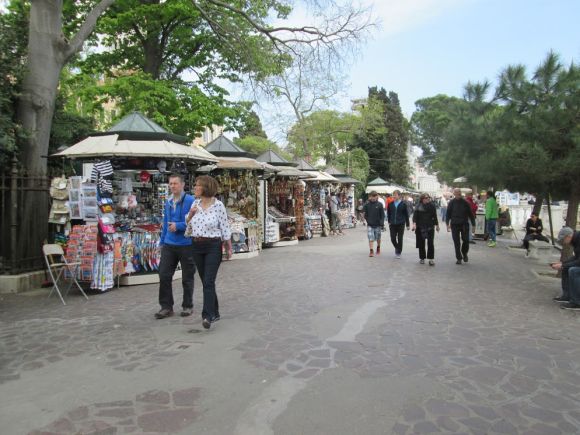
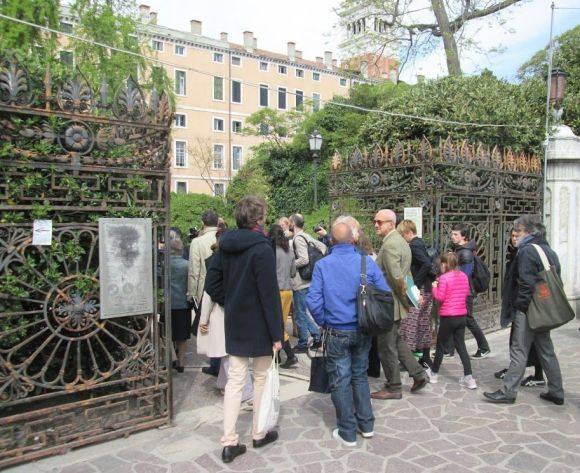
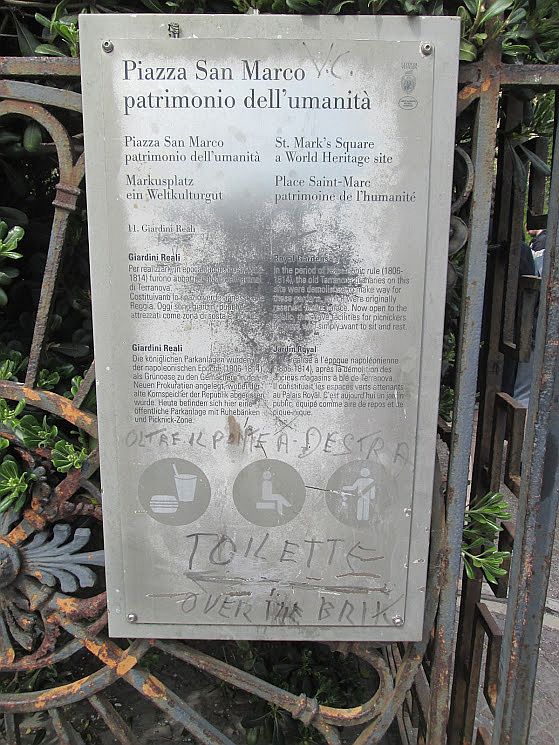
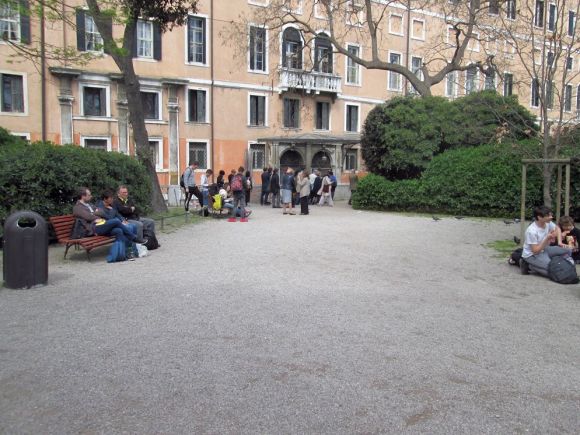

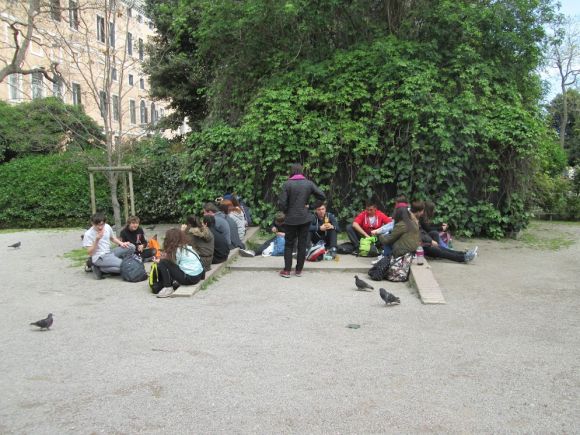
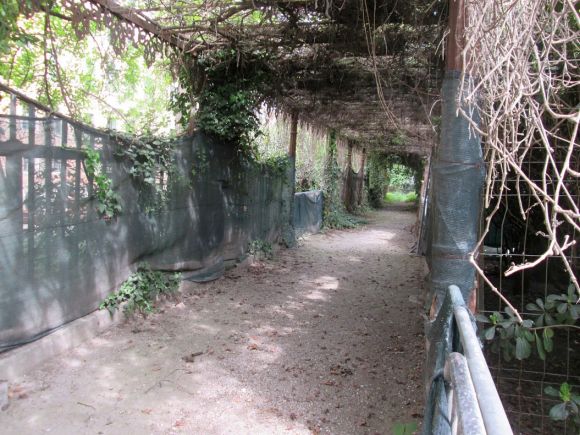

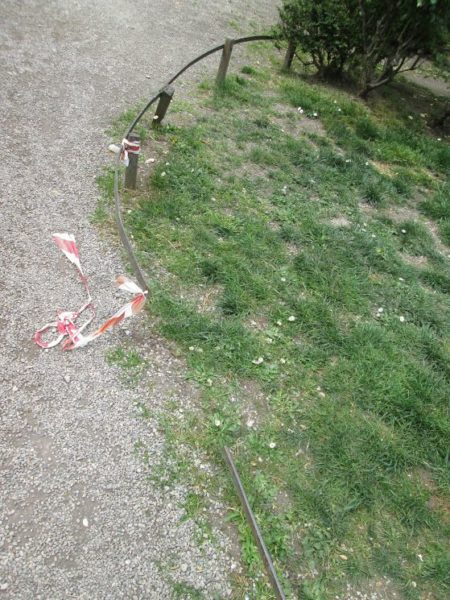
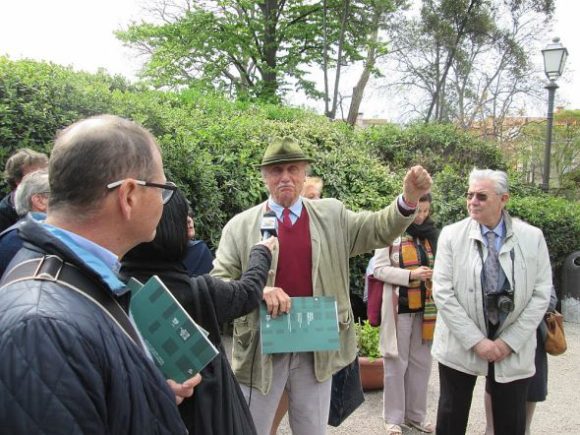

As we were wandering around the Rialto area examining Fascist mottoes, we also discovered an astonishing assortment of signs, symbols, inscriptions, and other indications of life from the past that are just sitting out there in the rain and wind deteriorating with nary a squeak from themselves, much less anybody else.
Here are some of the things we found. (Well — “found” isn’t quite right. They were hardly lost. But they do seem to be in the process of becoming lost.) I’m not saying we’re the only people who have ever noticed these, so no prizes or props to us. But it seems clear that nobody at the Superintendency of Fine Arts or Beni Culturali or any other government agency tasked with paying attention to the city’s treasures, monuments, or general aesthetic or historical elements has given them any thought whatsoever. I’m all for restoring paintings by Titian, but I’m also for respecting and even defending these literal voices which have been silenced because they’re not famous.
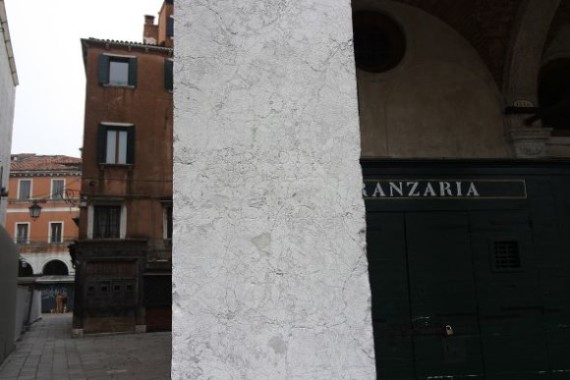
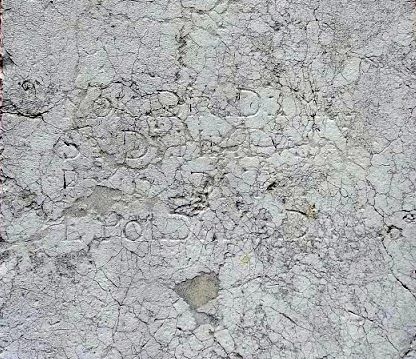
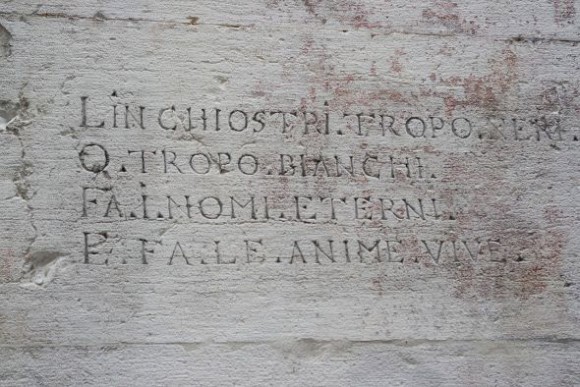
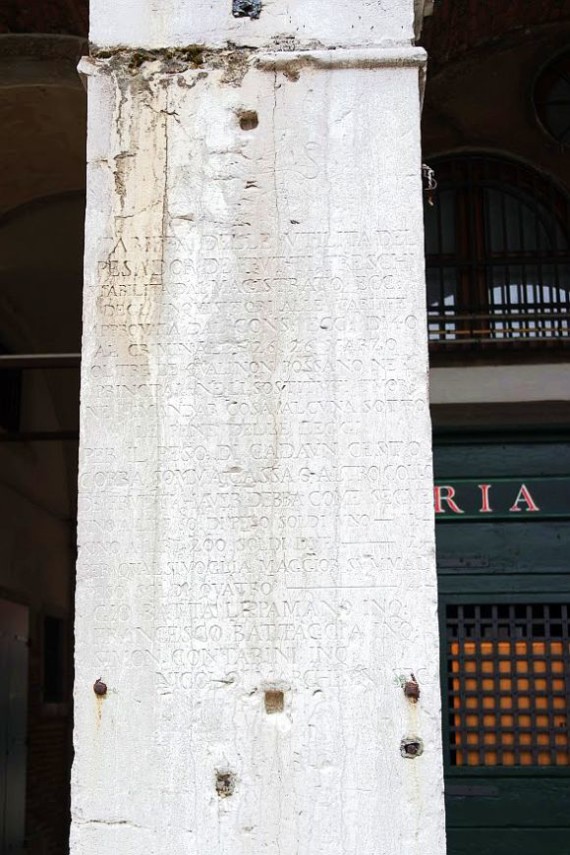
The proclamation on this column reads as follows (translation below by me):
TARIFFA DELLE VTILITA DEL PESADOR DE FRUTTI FRESCHI STABILITA DAL MAGISTRATO ECC. DEGLI INQUISATORI ALLE TARIFFE APPROVATA DAL CONS. ECC. DI 40 AL CRIMINAL 1726 26 MARZO OLTRE DE QUALI NON POSSANO NE PRINCIPAL NE LI SOSTITUTI TVOR (prendere) NE MANDAR COSA ALCUNA SOTTO LE PENE DELLE LEGGI PER IL PESO DI CADAUN CESTO CORBA (illegible) CASSA O ALTRO COLLO DE ERVETTA HAVER DEBBA COME SEGVE SINO A LIRE 60 DI PESO SOLDI VNO — 1 SINO AL 200 SOLDI DVE — 2 PER QVALSIVOGLIA MAGGIOR SVMMA IL PESO SOLDI QVATTRO — 4 GIOBATTA LIPPAMANO INQ FRANCESCO BATTAGGIA INQ SIMON CONTARINI INQ NICOLO MARCH (?) SEC
THE TARIFF OF THE COMMODITIES OF THE WEIGHMASTER (I invented this word; the pesador was the official weigher) OF FRESH FRUITS ESTABLISHED BY THE MOST EXCELLENT MAGISTRACY OF THE INQUISITORS OF THE TARIFFS APPROVED BY THE MOST EXCELLENT COUNCIL OF 40 OF THE CRIMINAL (the “Quarantia,” or Council of 40, was the supreme government office concerned with financial planning and the Mint; it was divided into three sections, and the “Criminal” was responsible for capital crimes and, as needed, the death penalty) 1726 26 MARCH BEYOND WHICH NEITHER PRINCIPALS OR THEIR SUBSTITUTES MAY TAKE (“tor” or “tuor” is still the common Venetian word for “take”) OR SEND ANY SORT OF THING UNDER PAIN OF THE LAWS FOR THE WEIGHT OF EACH BASKET CORBA (a corba was a long, large basket made of wicker or woven chestnut twigs, usually with handles) CHEST OR OTHER LARGE CONTAINER OF GREEN LEAFY VEGETABLES HAVING TO PAY AS FOLLOWS UP TO 60 LIRE OF WEIGHT ONE SOLDO – UP TO 200 TWO SOLDI – FOR WHATEVER AMOUNT ABOVE THAT FOUR SOLDI GIOBATTA LIPPAMANO INQUISITOR FRANCESCO BATTAGGIA INQUISITOR SIMON CONTARINI INQUISITOR NICOLO MARCH(?) SECRETARY.
I have only translated that bit about money and weight as literally as I can, but you clearly have to be in either the selling or the weighing business to be able to interpret what they mean. Please overlook this for now.
“Erbette,” literally “herbs,” refers to planty foods such as spinach, chicory, chard, etc. The indefatigable Tassini notes, in “Curiosita’ Veneziane,” that the Erbaria at Rialto was the place where such plants and fruits from the nearby islands and mainland were sold. I translate: “It existed in the 1300s, and in 1398 was paved with stone, while before it had been paved with wood. The business (“art”) of the vegetable-sellers was a ‘column’ of the Fruit-sellers guild, and in 1773 had 122 shops, 11 closed places (I am guessing those were the gated and locked storerooms), and 89 “sendings.” (Consignments?). He continues, “In 1581 this ‘art’ was allowed to have its altar in the church of SS. Filippo and Giacomo (church torn down by Napoleon) which had belonged first to the Bargemen, and also served for the use of the Linen-workers.”
